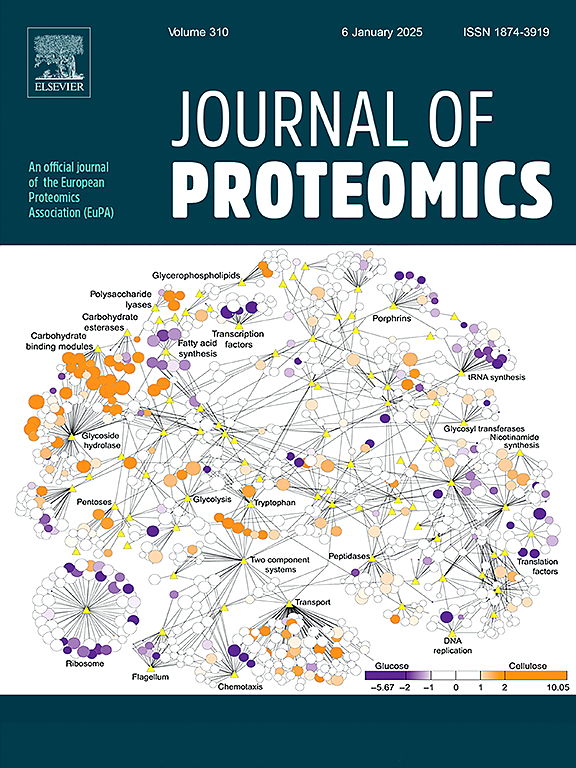脑形态形成条件下巴西棕榈(Copernicia prunifera)萌发和幼苗早期发育过程中的蛋白质组变化。
IF 2.8
2区 生物学
Q2 BIOCHEMICAL RESEARCH METHODS
引用次数: 0
摘要
本文通过将巴西棕榈胚分离为吸器(HA)和子叶叶柄(CP)两部分,分析了在脑形态形成条件下巴西棕榈幼苗发育过程中的蛋白质组学变化,并建立了这两个组织在四个发育阶段的描述性和定量蛋白质组学。在HA中鉴定出5205个蛋白,在CP中鉴定出6028个蛋白。这些蛋白质组富含维持脑形态形成状态的蛋白,并且包含一整套参与细胞呼吸和次生代谢物生物合成的蛋白。采用无标记方法的定量分析显示,HA中有583个蛋白和CP中有383个蛋白存在差异丰度,其中251个蛋白在数据集之间共享。结果表明,透明质酸参与了其自身和胚乳中食物储备的消化,为生长中的胚轴输送氮和碳源。在CP中差异丰富的蛋白质中,我们发现了来自细胞代谢的蛋白质和参与水解食物储备的蛋白质,如淀粉和蛋白质。这表明,除了胚乳和透明质酸外,CP也是胚胎轴的食物储备来源。意义:我们的研究结果还揭示了在prunifera种子和幼苗中参与活性氧清除、细胞壁重塑、呼吸代谢和蛋白质修复的特定蛋白的差异调控。这些发现对于理解驱动从种子到幼苗转变的能量代谢具有广泛的意义。在这项研究中,我们采用了最先进的蛋白质组学技术,包括定量质谱和生物信息学分析,这使我们能够创建一个大型数据集,这将是未来研究脑形态发生、光形态发生以及这些状态之间转换的生理和生化方面的宝贵资源。本文章由计算机程序翻译,如有差异,请以英文原文为准。
Proteome changes during the germination and early seedling development of carnauba palm (Copernicia prunifera) under skotomorphogenic conditions
We analyze the proteome changes during the development of the carnauba palm (Copernicia prunifera) seedlings under skotomorphogenic conditions, by separating the embryo into its two components: haustorium (HA) and cotyledonary petiole (CP) and established the descriptive and quantitative proteomes of these tissues across four developmental stages. 5205 proteins were identified in HA and 6028 in CP. These proteomes are rich in proteins known to maintain the skotomorphogenic state, and in a complete set of proteins involved in cellular respiration and biosynthesis of secondary metabolites. The quantitative analysis employing a label-free approach revealed that 583 proteins in HA and 383 in CP were differentially abundant, with 251 proteins shared between the datasets. The results showed that HA participates in the digestion of food reserves present in HA itself and in the endosperm, acting as a conduit of nitrogen and carbon sources for the growing embryo axis. Among the differentially abundant proteins in the CP, we identified the presence of proteins from the cellular metabolism and proteins involved in the hydrolysis of food reserves such as starch and proteins. This indicates that the CP, in addition to the endosperm and HA, serves as a source of food reserves for the embryo axis.
Significance
Our results also reveal the differential regulation of specific proteins involved in reactive oxygen species scavenging, cell wall remodeling, respiratory metabolism, and protein repair in seeds and seedlings of C. prunifera. These findings have broad implications for understanding the energy metabolism that drives the transition from seed to seedling.
For this study, we employed state-of-the-art proteomic techniques, including quantitative mass spectrometry and bioinformatic analysis, that allowed us to create a large dataset that will be a valuable resource for future research on the physiological and biochemical aspects of skotomorphogenesis, photomorphogenesis, and the transition between these states.
求助全文
通过发布文献求助,成功后即可免费获取论文全文。
去求助
来源期刊

Journal of proteomics
生物-生化研究方法
CiteScore
7.10
自引率
3.00%
发文量
227
审稿时长
73 days
期刊介绍:
Journal of Proteomics is aimed at protein scientists and analytical chemists in the field of proteomics, biomarker discovery, protein analytics, plant proteomics, microbial and animal proteomics, human studies, tissue imaging by mass spectrometry, non-conventional and non-model organism proteomics, and protein bioinformatics. The journal welcomes papers in new and upcoming areas such as metabolomics, genomics, systems biology, toxicogenomics, pharmacoproteomics.
Journal of Proteomics unifies both fundamental scientists and clinicians, and includes translational research. Suggestions for reviews, webinars and thematic issues are welcome.
 求助内容:
求助内容: 应助结果提醒方式:
应助结果提醒方式:


